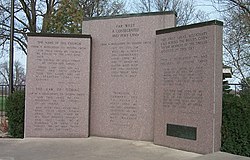2020 census
Caldwell County, Missouri – Racial and ethnic composition
Note: the US Census treats Hispanic/Latino as an ethnic category. This table excludes Latinos from the racial categories and assigns them to a separate category. Hispanics/Latinos may be of any race.| Race / Ethnicity (NH = Non-Hispanic) | Pop 1980 [9] | Pop 1990 [10] | Pop 2000 [11] | Pop 2010 [12] | Pop 2020 [13] | % 1980 | % 1990 | % 2000 | % 2010 | % 2020 |
|---|
| White alone (NH) | 8,594 | 8,293 | 8,786 | 9,035 | 8,172 | 99.24% | 98.96% | 97.96% | 95.87% | 92.71% |
| Black or African American alone (NH) | 4 | 14 | 12 | 39 | 65 | 0.05% | 0.17% | 0.13% | 0.41% | 0.74% |
| Native American or Alaska Native alone (NH) | 12 | 21 | 29 | 33 | 34 | 0.14% | 0.25% | 0.32% | 0.35% | 0.39% |
| Asian alone (NH) | 8 | 1 | 11 | 18 | 26 | 0.09% | 0.01% | 0.12% | 0.19% | 0.29% |
| Native Hawaiian or Pacific Islander alone (NH) | x [14] | x [15] | 0 | 2 | 7 | x | x | 0.00% | 0.02% | 0.08% |
| Other race alone (NH) | 1 | 1 | 8 | 3 | 23 | 0.01% | 0.01% | 0.09% | 0.03% | 0.26% |
| Mixed race or Multiracial (NH) | x [16] | x [17] | 56 | 151 | 337 | x | x | 0.62% | 1.60% | 3.82% |
| Hispanic or Latino (any race) | 41 | 50 | 67 | 143 | 151 | 0.47% | 0.60% | 0.75% | 1.52% | 1.71% |
| Total | 8,660 | 8,380 | 8,969 | 9,424 | 8,815 | 100.00% | 100.00% | 100.00% | 100.00% | 100.00% |
As of the 2020 census, the county had a population of 8,815. The median age was 43.5 years. 23.2% of residents were under the age of 18 and 21.1% of residents were 65 years of age or older. For every 100 females there were 103.4 males, and for every 100 females age 18 and over there were 99.3 males age 18 and over. 0.0% of residents lived in urban areas, while 100.0% lived in rural areas. [18] [19]
The racial makeup of the county was 93.6% White, 0.8% Black or African American, 0.4% American Indian and Alaska Native, 0.3% Asian, 0.1% Native Hawaiian and Pacific Islander, 0.6% from some other race, and 4.3% from two or more races. Hispanic or Latino residents of any race comprised 1.7% of the population. [20]
There were 3,522 households in the county, of which 29.0% had children under the age of 18 living with them and 21.7% had a female householder with no spouse or partner present. About 27.8% of all households were made up of individuals and 14.1% had someone living alone who was 65 years of age or older. [19]
There were 4,218 housing units, of which 16.5% were vacant. Among occupied housing units, 76.6% were owner-occupied and 23.4% were renter-occupied. The homeowner vacancy rate was 2.0% and the rental vacancy rate was 6.4%. [19]
2000 census
As of the census [21] of 2000, there were 8,969 people, 3,523 households, and 2,501 families residing in the county. The population density was 8/km2 (21/mi2). There were 4,493 housing units at an average density of 4/km2 (10/mi2). The racial makeup of the county was 98.56% White, 0.13% Black or African American, 0.33% Native American, 0.12% Asian, 0.00% Pacific Islander, 0.18% from other races, and 0.67% from two or more races. 0.75% of the population were Hispanic or Latino of any race.
There were 3,523 households, out of which 32.30% had children under the age of 18 living with them, 59.20% were married couples living together, 8.00% had a female householder with no husband present, and 29.00% were non-families. 25.50% of all households were made up of individuals, and 13.00% had someone living alone who was 65 years of age or older. The average household size was 2.51, and the average family size was 3.04.
In the county, the population was spread out, with 27.10% under the age of 18, 7.10% from 18 to 24, 25.10% from 25 to 44, 23.70% from 45 to 64, and 17.00% who were 65 years of age or older. The median age was 39 years. For every 100 females there were 97.60 males. For every 100 females age 18 and over, there were 93.90 males.
The median income for a household in the county was $31,240, and the median income for a family was $37,087. Males had a median income of $28,710 versus $19,523 for females. The per capita income for the county was $15,343. 11.90% of the population and 9.70% of families were below the poverty line. Out of the total population, 15.10% of those under the age of 18 and 12.90% of those 65 and older were living below the poverty line.




